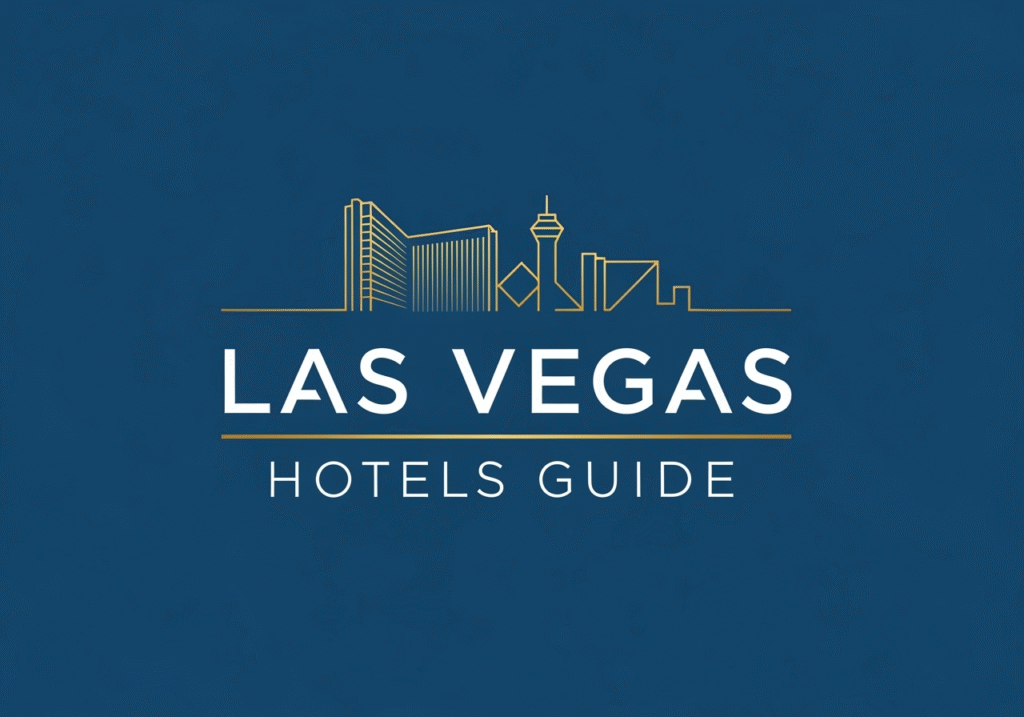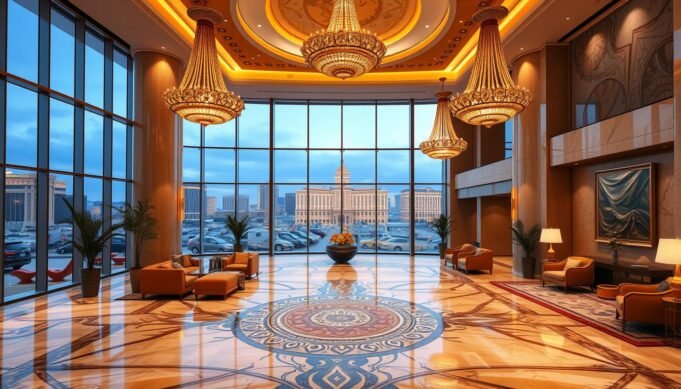I start every trip with one clear question: what vibe do I want from the lobby light to the room view at night? Vegas can feel huge fast—The Strip runs 4.2 miles—so location and timing shape your whole stay.
I’ll walk you through the real costs and cues that matter: resort fees, parking, surge rideshares, and checks like nearby Walgreens or Amazon Fresh delivery. These small details stack up and change a cheap night into an expensive one.
Photography and design matter if you care about how spaces feel. Think golden-hour light, crisp compositions, and rooms that look as good in person as they do in photos. I’ll show you how to read images so your room feels like a sanctuary, not just a backdrop.
Key Takeaways
- Pick location based on mood: Strip, Downtown, or Off-Strip.
- Factor hidden costs: resort fees, parking, taxes.
- Plan travel: rideshares, monorail, buses, and walking distance.
- Watch timing: weekends and conventions drive up prices.
- Read photos like a pro—lighting and detail reveal real rooms.
- Use rewards and direct bookings for better upgrades.
When to Book: Seasons, Weekdays, and Big Events That Spike Prices
Timing your trip can cut hundreds off the bill and change your whole Vegas vibe. Aim for early spring or fall for mild weather and lower crowds. Those windows give you calmer streets, usable pools, and better golden-hour light for hotel exteriors shot on a Canon EOS R5—nice detail if photos matter.
Midweek stays are the real hack: a Tuesday night can be up to $500 cheaper than a Saturday, depending on what’s in town. If your schedule is flexible, shift one night and pocket the difference. I often scan several date ranges and compare total cost, not just per-night rates.
Events and spikes to watch
Major conventions and festivals pack rooms fast. CES in January, EDC in May, big sporting events, and New Year’s Eve send rates sky-high. When those dates show up on the calendar, broaden your search radius and book early or pick midweek options.
“Book cancellable rates and set price alerts; when the times align and an event clears out, snag the drop.”
- Scan multiple ranges: look beyond flashy sale tags and check totals.
- Book flexible rates: cancel if a better drop appears.
- Mind the weather: triple-digit summer heat makes walking tougher and raises demand for pool-side rooms.
| Season | Typical demand | Booking tip |
|---|---|---|
| Early spring / Fall | Low–Moderate | Best value; target golden-hour photos and midweek stays |
| Summer / Holidays | High | Reserve pools and shaded rooms early; expect higher resort fees |
| Event peaks (CES, EDC, NYE, major sporting events) | Very High | Book months ahead or shift dates; widen search area |
Location Strategy: Strip, Downtown Fremont Street, or Off-Strip
Where you drop your bags shapes the whole mood of a Vegas stay—big lights, dive-bar grit, or roomy calm. I pick my base by vibe: spectacle, raw energy, or value. That choice guides walking plans, dining, and late-night returns.
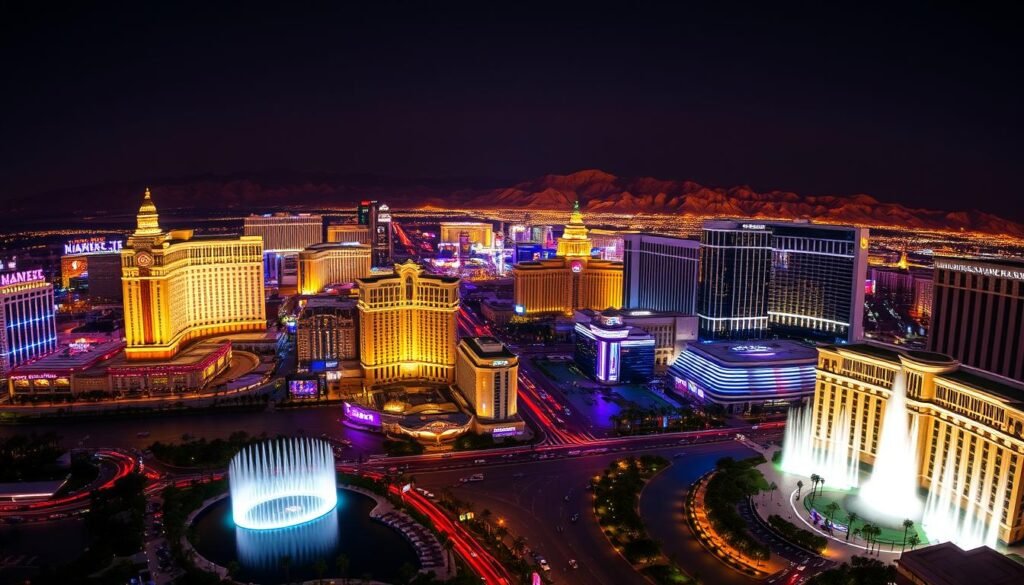
Strip: convenience and crowds
The Strip gives walkable access to major casinos, shows, and high-end restaurants. It’s 4.2 miles long, so distance matters if you plan a lot of walking.
Expect higher resort fees and big resort lobbies that are part destination, part stage.
Downtown: Fremont Street energy
Downtown usually runs cheaper than the Strip. Fremont Street is electric—live music, street bars, and a tighter party radius.
“Circa is the downtown outlier—epic sportsbook and a destination pool scene.”
Off-Strip: value and space
Off-Strip picks like Rio, Palms, and Virgin Hotels give calmer lobbies, easier parking, and room rates that stretch your budget. They’re short rides from the action.
- Tip: Place your hotel near your main casino or restaurants and you’ll save time and heat-stressed energy.
| Area | Vibe | Best for |
|---|---|---|
| Strip | Spectacle, walkable | Shows, top restaurants, major casinos |
| Downtown (Fremont Street) | Party, budget | Live music, value rates, tight nightlife |
| Off-Strip | Space, value | Parking, calmer stays, quick rides to Strip |
Transportation and Walking: Getting Around Sin City Without Overspending
The way you move through Sin City decides how much you spend and how tired you get. I plan routes like a short itinerary—cluster activities, pick a transit mode, and save both time and cash.
Budget first: the Deuce bus runs 24/7 as a double-decker along the Strip. It’s my go-to when my feet need a break and I want low cost travel for the day.
The Las Vegas Monorail runs about 7 am–midnight on weekdays and until 3 am on weekends. Day passes start near $15 and pay off if you hop between mid-Strip anchors.
- Free trams: South Strip trams link Bellagio and Luxor—no fare and fewer crowds.
- Rideshares: Uber and Lyft are fast but will surge around show exits. Walking a block off the Strip often lowers the price.
- Taxis and shuttles: Taxis add cost; many hotels don’t offer free airport shuttles—prebook if you want predictability.
“For late returns I use the monorail plus a short walk—reliable, safe, and simple.”
Walking the Strip can be deceptive—4.2 miles includes skybridges and maze-like casinos. Stay hydrated, wear comfy shoes, and pin nearby essentials like Walgreens for quick water runs.
| Option | Best use | Typical cost/time |
|---|---|---|
| Deuce bus | Low-cost, long day touring | 24/7, low fare |
| Monorail | Quick mid-Strip hops, late-night | Day pass ~ $15; extended weekend hours |
| Rideshare / Taxi | Door-to-door, luggage | Variable; surge at show end |
Total Price, Not Just Nightly Rate: Resort Fees, Taxes, and Parking
A great room rate can evaporate once resort fees and garage charges land on your folio. I always add the extras before I lock dates — the headline price is only the start.
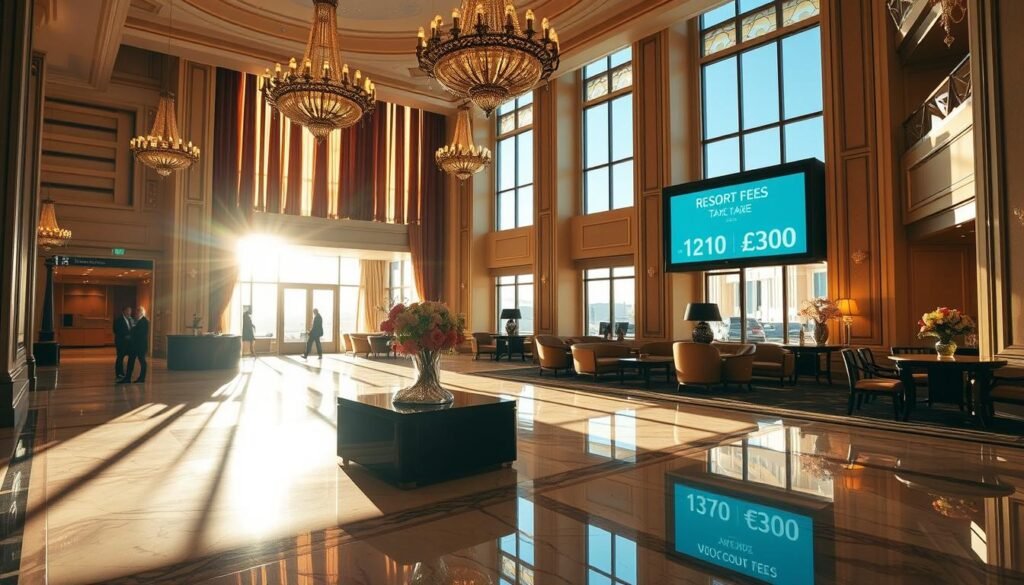
Resort fees vary wildly and often cover Wi‑Fi, gym access, and local calls — perks you may or may not use. Ask exactly what’s included and who actually pays for those services.
How resort fees add up
Resort fees show up per night. A low nightly rate can be offset by a $30–$50 daily charge. Multiply that by your stay and the price shifts fast.
Parking policies, who pays and who doesn’t
MGM, Caesars, Wynn, Venetian, and Resorts World typically charge for parking. The Strat, Sahara, Treasure Island, Palms, and Rio often have free options—handy if you drive.
Downtown usually has cheaper validation, though Circa is an exception with higher garage fees. Factor parking into your final cost before you book.
Pro tip: call the source
Check hotel websites and then call. Policies change—an agent can confirm current fees, local discounts, and whether your chosen room type alters the charge.
“I cross-check the site and then call; it saves surprises and sometimes nets a small waiver.”
- Do the math: nightly rate + resort fees + taxes + parking = true price.
- Book direct: easier cancellations and clearer adjustments if rates drop.
- Keep money where it matters: if garage fees climb, I’d rather spend that on an upgrade or a better view.
| Charge | Typical on the Strip | Notable exceptions |
|---|---|---|
| Resort fees | Common; varies by property | Confirm on hotel websites |
| Parking | Charged by major chains | Free at Strat (locals), Sahara, TI, Palms, Rio |
| Downtown validation | Often cheaper | Circa — pricier than peers |
things to consider when booking a hotel in las vegas
Pick your trip’s mission first: a foodie crawl, a show marathon, pool days, or downtown nights. I start there because one clear goal makes every other decision easier.
Map must-do activities and place your base near them. The Strip is 4.2 miles long—proximity saves steps, heat, and precious time.
Most hotels don’t offer free shuttles. Plan rides early and check nearby transit: monorail stops, Deuce bus lines, or free trams can change your day.
Confirm resort fees and parking up front. Those nightly extras shape your realistic budget and keep checkout surprises to a minimum.
- I choose a hotel category: a giant Strip icon, a high-energy Fremont gem, or a quieter Off‑Strip spot with easy rideshare access.
- Decide dining priorities—walkable restaurants or quick rides to buzzy spots—and peek at room photos for honest lighting and detail.
- Book flexible rates when possible; price drops and last-minute offers show up more than you might expect.
“Keep a light plan with buffers—time evaporates here, and that slack is part of the vacation magic.”
| Checklist | Why it matters | Quick action |
|---|---|---|
| Purpose | Steers location and schedule | Pin one main activity |
| Transport | Reduces walking and cost | Check nearby stops |
| Fees & photos | Real price and room truth | Confirm fees; scrutinize images |
Booking Channels and Rewards: Direct, Discounts, and Player Perks
A direct booking is like a backstage pass at check-in—more access, more flexibility. I aim for direct rates on hotel websites first. Hotels favor guests who book direct for upgrades, quicker fixes, and flexible cancellations.
Why direct bookings matter
Third-party bookings can get bumped first if a property tightens rooms. Book direct and you move up the priority list during busy times.
Pro tip: call after you reserve. Agents can sometimes match an online promo or note upgrade preferences.
Player rewards and tier play
Sign up for MGM Rewards, Caesars, and Wynn. MGM often has the best suite discounts; Wynn runs targeted suite promos. Caesars will tier-match up to Diamond, and downtown spots like Plaza and Golden Nugget offer similar status advantages.
Stacking deals and inbox wins
I stack where allowed—seasonal promos plus a players’ club rate can save real money. Book a standard room first, then watch email offers; targeted upgrades often arrive cheaper than booking a suite outright.
“Keep your dates slightly flexible—shift one night and you may unlock a loyalty discount or an email-only offer.”
- I go direct when I can for upgrades and flexible cancellations.
- Sign up for rewards and monitor inbox upgrades after booking.
- Ask politely at check-in about available upgrades and specific views.
| Channel | Typical advantage | Quick action |
|---|---|---|
| Direct (websites) | Priority for upgrades, flexible changes | Call after booking; enroll in rewards |
| Third-party | Often lower upfront rates | Confirm walking policy in advance |
| Players’ club | Tier promos, targeted discounts | Join before your stay; track emails |
Final note: loyalty is the quiet lever that makes nicer stays feel within reach. I frame my travel around rewards and small timing moves—it saves money and lands better rooms more often.
Room Types, Views, and Upgrades: Getting the Experience You Want
Before you lock dates, decide whether space or skyline matters more for your nights. That single call—suite or view—shapes everything from light at dawn to where you linger with coffee.
Standard rooms vs suites: view categories and realistic upgrade paths
Standard rooms often shine after recent renovations. They can deliver crisp textures, smart layouts, and tasteful lighting that photograph like editorial work—think Canon EOS R5, RF 24‑70mm at f/4, warm diffused light, HDR-balanced windows.
Suites buy space: separate living areas, larger baths, and often better sightlines. But a high-floor room with a premium view can beat a small suite for atmosphere.
The “$20 trick” etiquette vs official offers at check-in
Book a base room and watch post-booking emails for discounted upgrades. The old $20 trick rarely works now—properties might sell a paid view upgrade, but suites don’t appear for pocket change.
“Ask specifically—high floor, corner, fountain view. Clarity helps agents find options.”
- I pick what matters first: size or skyline, then chase that category.
- At check-in, I request exact upgrades and tip for earned service, not as a bribe.
- For short trip las, a targeted paid upgrade transforms limited time more than anything else.
| Option | Typical advantage | Best use |
|---|---|---|
| Standard room | Lower rate, renovated finishes | Value-focused nights and long stays |
| High-floor view | Better light, skyline photography | Short trips and sunrise lovers |
| Suite | More space, upgraded baths | Celebrations and longer stays |
Amenities That Matter: Pools, Dining, Entertainment, and Shows
Amenities can make or break your trip—pick what fills your days and nights.
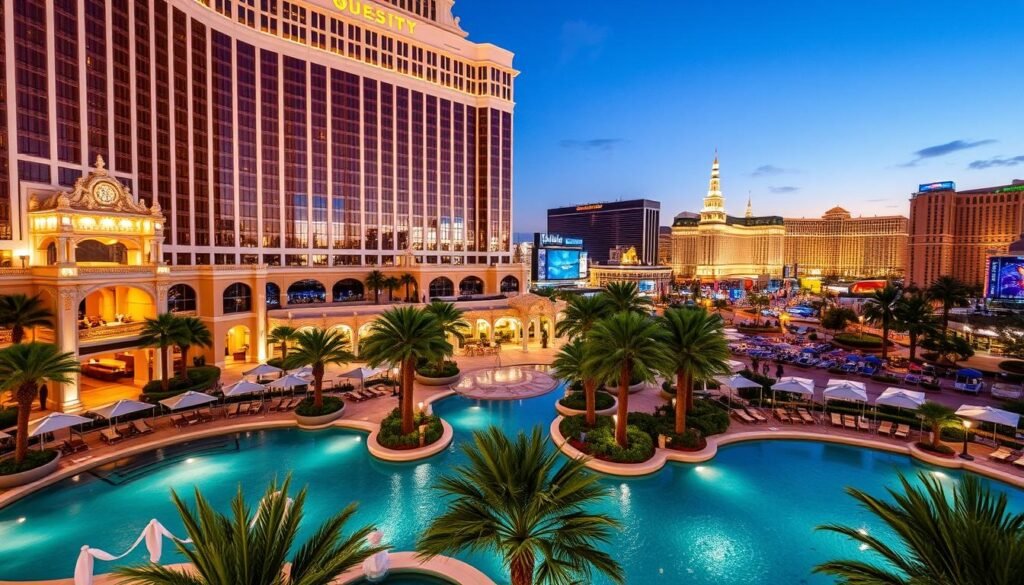
Pool seasonality and dayclub vibes vs relaxing resort pools
I match the pool scene to my mood. Some decks are dayclub loud; others are calm and shady.
Fit matters: pool parties run peak season and draw crowds, while resort pools are best for slow mornings and golden-hour photos.
Dining and late-night options: on-site restaurants vs nearby hotspots
Dining can shape your nightly rhythm. Big resorts host destination restaurants, but nearby gems often open late.
Check hours and menus ahead—late-night comfort food saves you after a late show or walk back from the Strip.
On-property entertainment: casinos, shows, and sports viewing
The right on-site entertainment keeps the night rolling. A lively casino floor, a headline residency, or a packed sportsbook all change where you spend time.
“Circa’s pool and sportsbook combo is its own destination—plan a half-day there if it fits your trip.”
- Match mood: party pool or quiet retreat.
- Check access: some perks live behind fees; confirm who pays and what’s included.
- Plan logistics: proximity to restaurants and shows saves late-night hassles.
| Amenity | Typical vibe | Quick tip |
|---|---|---|
| Pool | Dayclub energy or serene resort space | Confirm season, entry rules, and photos |
| Dining & Restaurants | On-site fine dining or nearby casual spots | Check hours; reserve for peak nights |
| Entertainment & Shows | Residency, comedy, sports viewing | Buy tickets early; map travel time |
| Casino / Resorts | Round-the-clock action or calm lounges | See if amenities are bundled with your rate |
Photogenic Stays: Visual Quality of Rooms and Spaces
Great hotel photos tell you more than the amenities list ever will. I scan galleries like a photographer—looking for honest light, consistent color, and clear texture. That visual read often predicts how a stay will feel from arrival through checkout.
What to look for in hotel photography
Editorial, magazine-worthy interiors matter. Spot clean whites, balanced highlights, and images shot without blown windows. The best galleries feel consistent—room, hallway, and lobby images that match in tone and care.
Lighting and composition cues
Trust photos that show golden-hour warmth and soft, diffused interiors. Look for three-point lighting, rule-of-thirds framing, leading lines, and tack-sharp textures in linens and tile.
- I favor shots that read like Canon EOS R5 work—RF 24‑70mm at f/4, ISO 100, 1/125s, RAW, pro color grade, HDR-balanced.
- If only one hero image exists, search guest photos; editorial consistency across images is a good sign.
- Remember: visual quality should match the listed price—fine images often mean a cared-for destination in this city.
“I treat the gallery as a promise—when photos are honest, the stay usually is too.”
Policies, Service, and Trip Type: Match Your Hotel to Your Plans
Policies shape more than price—they shape your day: cancellation windows, late checkout, and overbooking can flip plans fast. Read them like part of your itinerary and treat the front desk as your ally.
Cancellation windows, late checkout, and overbooking “walking”
I watch cancellation rules first—direct bookings often let you adjust or cancel up to 72 hours before arrival. That breathing room is worth a little extra on short trips.
Late checkout is a quiet win. Ask when you book and again at check-in; alignment with flights can buy you pool time or a calm morning instead of rushed packing.
Overbooking still happens. Third-party reservations are more likely to be walked; direct guests get priority and better re-accommodation at sister properties.
Weekend party trip vs family vacation vs event-focused stays
For a weekend party sprint, lean into resorts with active pool scenes and nightlife nearby. Proximity matters—less walking, more time in the action.
A family vacation needs quiet rooms, reliable dining, and easy transit. Pick hotels with clear signage, calm front desks, and tidy hallways—those editorial cues often reflect better housekeeping and service.
Event-focused trips are all about location. Staying near the venue saves precious time and stress when schedules run tight.
“Policies are part of service—flexibility and clear communication tell you how you’ll be treated on property.”
- I read cancellation windows closely—72-hour rules on direct rates give me options.
- I confirm late checkout at booking; it can turn a flight day into pool hours.
- I favor direct bookings to reduce the chance of being walked and get better re-accommodation.
| Trip type | Policy focus | Quick pick |
|---|---|---|
| Weekend party | Flexible arrival, late checkout | Resort with active pool and nightlife access |
| Family vacation | Quiet rooms, clear service | Hotels with family dining and easy transit |
| Event trip | Cancellation leniency, proximity | Stay near venue; prioritize short travel time |
Conclusion
Decide what will make you smile each morning, then build the rest around that moment.
Pick timing smartly—midweek nights often cut prices and dodge big event spikes like CES or EDC. Budget the full cost: nightly rate plus fees, parking, and taxes so your wallet matches your plans.
Choose a base that fits your vibe—Strip spectacle, Fremont Street buzz, or calmer off‑Strip areas—and use Deuce, monorail, and free trams to save energy and cash in summer weather.
Book direct when you can, stack rewards, and ask politely at check‑in; small upgrades change how the entire stay feels.
Finish with a view that holds up in photos: golden hour, Canon EOS R5, f/4, ISO 100, 1/125s—HDR-balanced skyline glow and tack‑sharp foregrounds that seal the trip las vegas memory like an editorial frame.
FAQ
When should I book to get the best rates — are weekdays cheaper than weekends?
Midweek stays—especially Tuesday through Thursday—often cost a lot less than Friday–Saturday nights. Aim for early spring or fall for cooler weather and lower demand. Avoid major event weeks like CES, EDC, big boxing or UFC cards, and New Year’s Eve when prices spike.
How do resort fees and taxes affect the total cost?
Resort fees are added per night and can equal a significant portion of the nightly rate. Taxes and local fees stack on top. Always check the total price at checkout or call the property directly so you’re not surprised by the final bill.
Should I stay on the Strip, downtown Fremont Street, or off-Strip?
Strip hotels put you at the center of shows, nightlife, and iconic pools—great for first-time visitors but pricier and busier. Fremont Street downtown offers lower rates and a lively, vintage vibe. Off-Strip properties like Palms or Virgin Hotels often give more space and value, with short rides to main attractions.
What transportation options should I plan for getting around?
Use the Deuce bus and the Las Vegas Monorail for predictable fares along the Strip. Free trams link some resorts. Rideshares and taxis are convenient but watch for surge pricing during big events or late nights. The Strip is walkable but long—pack water and sun protection in summer.
Do hotels validate parking or still charge guests?
Parking policies vary. Premium resorts often charge daily parking fees, while some casinos or downtown hotels validate or offer free parking for players and loyalty members. Confirm parking rules and potential validation before you arrive.
Is booking direct better than using third-party sites?
Hotels often prioritize direct bookings for upgrades, free cancellations, and better customer service. Join loyalty programs—MGM Rewards, Caesars Rewards, Wynn Rewards—to earn perks. Use third-party deals for price comparison, but call the hotel to ask about matching rates or perks.
How do player rewards and tier matching work?
Casino loyalty programs reward play with free nights, room upgrades, and dining credits. Frequent players can tier-match between programs; policies differ by brand. Ask loyalty desks about current promotions and targeted offers before booking.
What room types and views are worth paying extra for?
A Strip-facing view or a higher-floor suite makes evenings and sunsets memorable. Standard rooms are fine for short stays; upgrade if you want space, privacy, or a balcony. Check real guest photos and hotel galleries to set realistic expectations.
Are pools and dayclubs included or seasonally restricted?
Pool access depends on the property and season. Some resorts open pools only during peak months and operate dayclubs with separate cover charges. If pool time matters, verify season dates, reservation rules, and any additional fees.
How do I judge hotel photos and marketing images for reality?
Look for multiple guest photos on review sites and social media. Pay attention to lighting, floor level, and staging. High-end editorial photos can be aspirational—cross-check with recent traveler images for accuracy.
What cancellation policies should I watch for?
Cancellation windows vary—some rates are fully refundable up until a few days before arrival, others are nonrefundable. Event weeks and special promos often lock in stricter rules. Keep travel insurance in mind for major events or flexible plans.
Any tips for balancing nightlife party trips and family vacations?
Pick a property that matches your vibe: high-energy resorts with dayclubs and club access for party trips; family-friendly resorts with calmer pools, kids’ options, and easy dining for family stays. Check noise policies and room locations—ask for a quiet floor if you need rest.
How can I avoid surprise fees at check-in or check-out?
Ask the front desk about resort fees, incidental holds on cards, parking charges, and Wi‑Fi costs before you confirm. Request a detailed rate breakdown in writing. Calling ahead often saves unwanted surprises.
Are there reliable ways to get upgrades at check-in?
Being loyal to a brand and booking direct helps. Polite check-ins, off-peak arrival times, and membership status improve your chances. Some guests use modest, respectful offers at the desk—results vary, and major events reduce upgrade availability.

